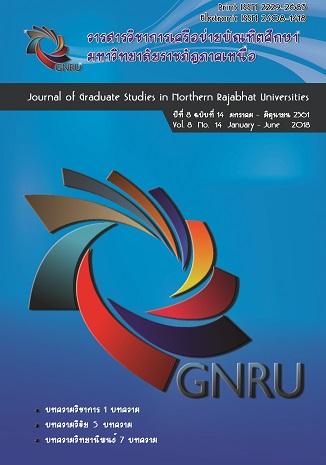การมีส่วนร่วมของชุมชนในการวางแผนกลยุทธ์การตลาดเพื่อส่งเสริมการดำเนินงานของกลุ่มนวดเพื่อสุขภาพ กรณีศึกษา กลุ่มนวดเพื่อสุขภาพวัดคลองคาง จังหวัดนครสวรรค์; The participation of communities for planning marketing strategies to enhance the performance of a heal
Main Article Content
Abstract
งานวิจัยนี้มีวัตถุประสงค์ เพื่อศึกษาปัจจัยที่สำคัญที่ส่งผลต่อคุณภาพการบริการนวดเพื่อสุขภาพของกลุ่มนวดเพื่อสุขภาพวัดคลองคาง จังหวัดนครสวรรค์ และศึกษาการมีส่วนร่วมของชุมชนนำไปสู่การวางแผนกลยุทธ์การตลาดเพื่อเป็นแนวทางในการส่งเสริมการดำเนินงานของกลุ่มนวดเพื่อสุขภาพวัดคลองคาง จังหวัดนครสวรรค์ โดยเก็บรวบรวมข้อมูลจากประชากร 2 กลุ่ม คือ กลุ่มที่ 1 ได้แก่ หมอนวด คณะกรรมการวัดคลองคาง และเจ้าอาวาสวัดคลองคาง จำนวน 31 ตัวอย่าง กลุ่มที่ 2 ได้แก่ ผู้เคยใช้บริการนวดเพื่อสุขภาพ มีอายุ 20 ปีขึ้นไป จำนวน 400 ตัวอย่าง
ผลการศึกษา พบว่า โมเดลคุณภาพการบริการมีความสอดคล้องกับข้อมูลเชิงประจักษ์อยู่ในเกณฑ์ดี นอกจากนี้ผลงานวิจัยแสดงว่า คุณภาพด้านการจัดการ (Administrative Quality) เป็นปัจจัยที่สำคัญที่สุด รองลงมาคือ คุณภาพด้านเทคนิค (Technical Quality) คุณภาพด้านการสร้างความสัมพันธ์ระหว่างบุคคล (Interpersonal Quality) และ คุณภาพด้านสิ่งแวดล้อม (Environment Quality) ตามลำดับ สำหรับกลยุทธ์ที่ควรมุ่งเน้น คือ กลยุทธ์การการเติบโต (Growth Strategy) แบบเจาะตลาด (Market Penetration) และแบบรวมตัวไปข้างหลัง (Backward Integration)โดยการมุ่งลูกค้ากลุ่มเล็ก เน้นการสร้างความแตกต่างในการบริการ พัฒนาทรัพยากรบุคคลหรือพนักงาน โดยเฉพาะความเชี่ยวชาญด้านการนวด สำหรับกลยุทธ์การเติบโตแบบรวมตัวไปข้างหลัง ทำให้ทางกลุ่มสามารถใช้ทรัพยากรมี่มีอยู่ได้อย่างเต็มที่
The first main purpose of this research was to develop and validate a causal relationship model comprising factors affecting service quality of health massage group of Wat Klong Kang in Nakhon Sawan Province. The sample derived by random sampling, consisted of 395 people who having experience in a health massage group and having age over 20 years olds.The instrument for studying the first objective was a questionnaire. The second main purpose of this research was to develop marketing strategies of the health massage group of Wat Klong Kang in Nakhon Sawan province. The second objective was collected data from the participation of communities such as therapists, committees of Wat Klong Kang, and the abbot of Wat Klong Kang. The total number of representatives of Wat Klong Kang communities were 31sample.
The finding found that the service quality model show a good model fit with the empirical data. Goodness of fit measures were found to be: Chi-square (χ2) = 562.275; df = 120; Relative Chi-square (χ2/df) = 4.686; Goodness of Fit Index (GFI) = 0.84; Comparative Fit Index (CFI) = 0.91; Root Mean Square Error of Approximation (RMSEA) = 0.10. The results also showed that administrative quality is the most important factors followed by technical quality, interpersonal quality and environment quality respectively. The main marketing strategies should emphasize growth strategies such as market penetration, backward integration. Market penetration means that the health massage group should pay attention of a small group of customer. The therapists of health group should be developed massage skill and knowledge. Moreover, backward integration strategy also should be used because this strategy leads to efficiently using resources.
Article Details
References
ชลิดา บุญเรืองขาว. (2551). การศึกษาสภาพแวดล้อมธุรกิจสปาและนำเสนอกลยุทธ์การแข่งขันและการแก้ปัญหาเพื่อขยายฐานกลุ่มลูกค้า: กรณีศึกษาร้านซีดา บิวตี้ แอนด์สปา. การค้นคว้าอิสระบริหารธุรกิจมหาบัณฑิต (ประกอบการ). มหาวิทยาลัยหอการค้าไทย, กรุงเทพฯ.
ชลีญา อ้นทองทิม, เบญจวรรณ สุจริต, มาณี ชูเอียด. (2555). กลยุทธ์การบริหารทรัพยากรมนุษย์ที่ส่งผลต่อการเพิ่มประสิทธิภาพการปฏิบัติงานของพนักงานองค์การบริหารส่วนตำบลในจังหวัดอุตรดิตถ์. วารสารวิชาการเครือข่ายบัณฑิตศึกษามหาวิทยาลัยราชภัฏภาคเหนือ, 2(2), 161-172
ทรรศนะ บุญขวัญ. (2555). การจัดการเชิงกลยุทธ์.กรุงเทพฯ: แมคกรอ-ฮิล.
วราพรรณ เพ็งแจ่ม.(2553). การส่งเสริมสุขภาพผู้มีปัญหาโรคปวดเมื่อยกล้ามเนื้อด้วยภูมิปัญญาท้องถิ่น. Journal of Nakhonratchasima College. 4(2), 27-35.
อนุรักษ์ ปัญญานุวัฒน์. (2548). การศึกษาชุมชนเชิงพหุลักษณ์: บทเรียนจากการวิจัยภาคสนาม. (พิมพ์ครั้งที่ 6). กรุงเทพฯ: โครงการเสริมสร้างการเรียนรู้เพื่อชุมชนเป็นสุข.
Clemes, M. D., Shu, X., & Gan, C. (2014). Mobile communications: a comprehensive hierarchical modelling approach. Asia Pacific Journal of Marketing and Logistics, 26(1), 114-146.
Dagger, T. S., Sweeney, J. C., & Johnson, L. W. (2007). A hierarchical model of health service quality scale development and investigation of an integrated model. Journal of Service Research, 10(2), 123-142.
Grönroos, C., & Ravald, A. (2011). Service as business logic: implications for value creation and marketing. Journal of Service Management, 22(1), 5-22.
Hair, J. F., et al. (2010). Multivariate data analysis: A global perspective. Upper Saddle River, NJ, Pearson Education.
Kline, R. B. (2005). Principles and practice of structural equation modeling. New York, Guilford Press.
Lo, A., Qu, H., & Wetprasit, P. (2013). Realms of Tourism Spa Experience: The Case of Mainland Chinese Tourists. Journal of China Tourism Research, 9(4), 429-451.
Lo, A., Wu, C., & Tsai, H. (2015). The Impact of Service Quality on Positive Consumption Emotions in Resort and Hotel Spa Experiences. Journal of Hospitality Marketing and Management, 24(2), 155-179.
Pallant, J. (2007). SPSS Survival manual: A step by step guide to data analysis using SPSS for windows.
Maidenhead, England; New York, McGraw Hill/Open University Press.
Thongkern, T. (2016). Assessing the Behavioural Intentions of Spa Customers: An Empirical Analysis. Doctoral dissertation. Lincoln University, Chrischurch, NZ.
Tsai, H., Suh, E., & Fong, C. (2012). Understanding male hotel spa-goers in Hong Kong. Journal of Hospitality Marketing & Management, 21(3), 247-269.


